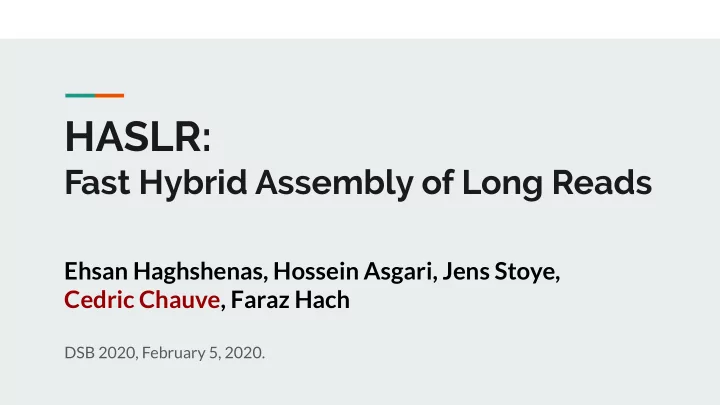

HASLR: Fast Hybrid Assembly of Long Reads Ehsan Haghshenas, Hossein Asgari, Jens Stoye, Cedric Chauve, Faraz Hach DSB 2020, February 5, 2020.
Summary Features of HASLR ● Simple ideas. ○ Re-use efficient, well-tested, tools. ○ Fast and memory efficient. ○ Low mis-assembly rate. ○ Good contiguity and gene completeness. ○ Base-level accuracy similar to others tools after polishing. ○
Long read assembly: self assembly (Ruan J. and Li H., 2019)
Long read assembly: hybrid assembly Self Assembly (Koren S. and Phillippy AM., 2015)
HASLR’s methodology
Short read assembly Build a short read assembly using Minia ● ○ -kmer-size 49 -abundance-min 3 -no-ec-removal Identify “unique” short read contigs ● We assume longer contigs are more likely to come from unique regions of the ○ genome Let f avg and f std be average and standard deviation of “mean k-mer frequency” ○ of the longest 30 short read contigs Every short read contig whose mean k-mer frequency is below f avg +3 f std is ○ considered to be unique
Aligning unique contis to long reads Align unique contigs against longest 25x coverage of long reads ● Using minimap2 ○ Coverage is calculated based on the estimated genome size ○ For each long read, select a subset of non-overlapping unique contigs ● alignments whose total identity score is maximal S(j)= max{ S(j-1) , S(prev(j)) + a j [nmatch] } largest index z<j such that a j and a z are non-overlapping number of matches in j -th alignment
Backbone graph Two nodes for each unique contig ● representing forward and reverse ○ strand Edges are added between nodes if ● their corresponding unique contigs align to some long reads consecutively one edge for forward and another ○ for reverse strand
Mis-mappings Wrong alignment of unique ● contigs onto long reads cause wrong edges Yeast PacBio dataset
Mis-mappings Wrong alignment of unique ● contigs onto long reads cause wrong edges Remove low support edges ● Less than 3 long reads ○ Still there are some artifacts in the ● graph structure Yeast PacBio dataset
Graph cleaning Tip Simple bubble Super bubble
Consensus calling Find the region of unique contigs ● that is shared by all supporting long reads Calculate consensus using partial ● order alignment SPOA in global alignment mode ○ Can be done for each edge ● independently Easy to parallelize ○
Generating the final assembly Generate one contig per simple path (unitig) in the graph ● For each simple path, concatenate the sequence of the unique short ● read contigs and the consensus sequences.
Results
Simulated dataset
Simulated dataset
Real dataset
Real dataset
Gene completeness
Effect of polishing Polishing is done using arrow (https://github.com/PacificBiosciences/GenomicConsensus)
Faster polishing? What if we only polish regions between unique contigs? ● Not integrated with HASLR yet ●
Summary HASLR is a fast and memory efficient assembly pipeline. ● It relies on a combination of simple ideas and well-tested assembly tools. ● It generates a conservative assembly, characterized by a low rate of ● mis-assemblies at the expense of a lower genome fraction. Its main innovation is the introduction of the backbone graph for ● scaffolding and gap filling. Available on bioconda and github ● https://github.com/vpc-ccg/haslr ○
Future directions Advanced bubble/tip cleaning algorithm. ● Integrating fast polishing module. ● Support for ultra-long nanopore reads. ● Improving genome coverage. ● Using an OLC approach on unused long reads ○ Diploid genome assembly. ● Clustering long read subsequences into two groups before consensus calling ○
Thank you!
-
-
Recommend
More recommend